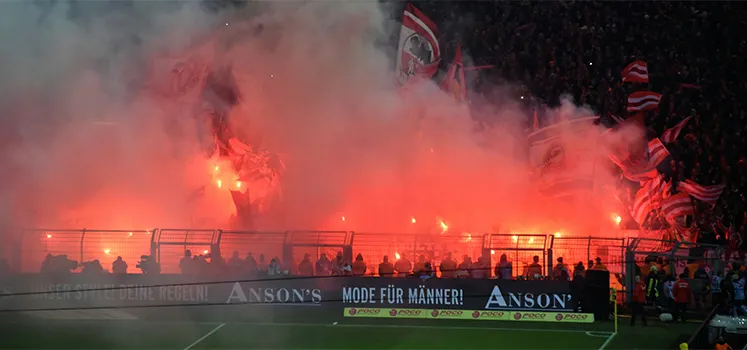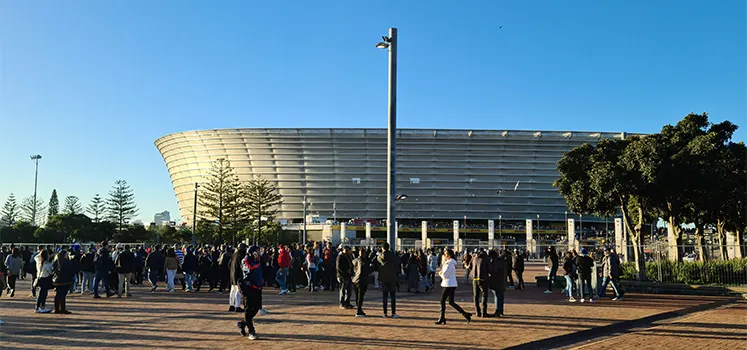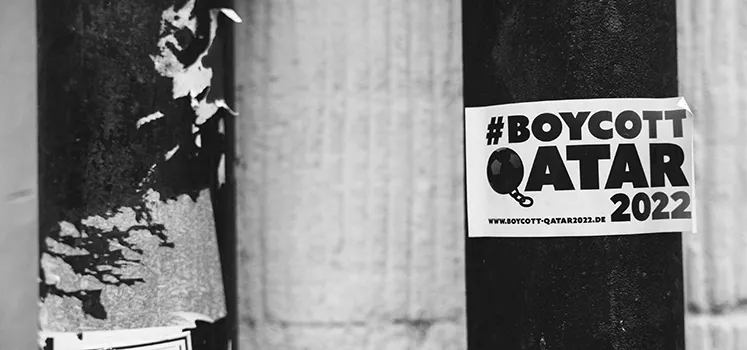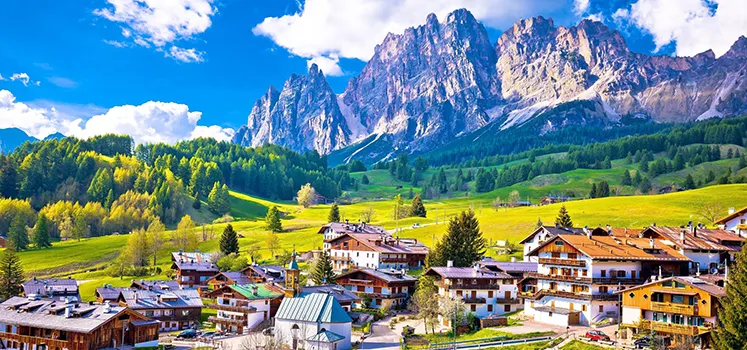Sport's greatest stage and it's greatest risks in 2026
by Christian Hill | 9th October 2025

What are the biggest security risks for sports events in 2026?
Intelligent Protection has been widely featured in the media over the past decade or more, including The Telegraph, The Times, The Guardian and other international publications, for expert commentary on the risks facing athletes, teams, and high-profile visitors. As we look ahead, 2026 stands out as a defining year in global sport, and with it comes unparalleled security challenges.
The year 2026 promises to be one of the most significant in the global sporting calendar for decades. With the FIFA World Cup stretching across the United States, Canada and Mexico, the Winter Olympics in Milan–Cortina, the Commonwealth Games in Glasgow, and annual fixtures such as Wimbledon and the US Open, the eyes of the world will once again turn to sport.
For many, these events are about celebration, competition and national pride. For celebrity clients, sporting team owners, elite athletes, their families, and UHNW visitors travelling as VIP guests or sponsors, they also represent a time of heightened vulnerability. The scale of these occasions, combined with their global visibility, creates a complex web of risks that must be anticipated and managed with precision. At Intelligent Protection, we turn foresight into readiness, ensuring our clients enjoy the moment, while we handle the risks.
Insights From the Present
We should start by saying that this article is in a longer format that our usual articles due to the insights that we wanted to up across with case studies. We hope this assists in decission making and is more informative.
The unpredictability of major sport has been on full display this year. At the Ryder Cup in New York, the opening ceremony was moved forward due to weather threats, while crowd behaviour crossed the line with insults and ejections, forcing organisers to increase security for the final day. For VIPs, the risk wasn’t just inconvenience, it was the potential for reputational damage or confrontation caught on camera in a hostile crowd.
At the US Open, the attendance of President Trump created a stress test of stadium security. Entry lines collapsed under the weight of enhanced screening, delaying the men’s final and leaving VIPs stranded in exposed areas. Inside, a photographer stepping onto the court at match point showed how even accredited insiders can bypass controls and cause chaos. For high-profile guests, that raises real questions about how well their own access and privacy can be protected.
Even domestic sport underlines the risks. In 2023, when Wrexham were playing a promotion-decider in the National League, broadcast crews required dedicated close protection against the risk of pitch invasions. Crowds surged toward cameras and players, and the lack of separation between fans and media meant accredited staff were prime targets for intimidation, assault, or reputational exposure if live coverage was disrupted.
For our clients, the message is clear: public events move fast, and visibility creates vulnerability. Secure arrivals, discreet escorts, and proactive close protection ensure that celebrities, owners and families are never left exposed, whether in a 10,000-seat stadium or a 60,000-seat arena.

The Commonwealth Games - A Different Kind of Challenge
Glasgow 2026 will be compact, contained within the city boundary and relying on legacy venues. But that density creates complications: crowded transport routes, symbolic protests, and the challenge of securing ceremonies that attract global attention.
For UHNW visitors, families of athletes and celebrity guests, moving discreetly through such a busy environment demands more than a driver and a bodyguard. It requires professional close protection supported by risk and threat management, combining real-time intelligence, route planning, and counter-surveillance with vetted transport and private access routes. Secure accommodation with controlled entry points, thorough staff vetting, and close coordination with event organisers and public agencies all form part of the protective strategy.
In an event as compact and high-profile as Glasgow 2026, layered security and threat management will be essential: from monitoring potential protest activity to anticipating bottlenecks and crowd surges. The goal is not only to protect clients physically, but to reduce exposure to disruption, reputational risk and unnecessary stress.
Insights from Birmingham 2022
At the 2022 Commonwealth Games, Intelligent Protection provided security at UK House (The Exchange) and the International Convention Centre (ICC) in Birmingham, where government ministers, investors, protected persons and even the UK Prime Minister, Boris Johnson, gathered daily. Our involvement began well before the Games, with full security assessments of both venues, assessing risks, identifying vulnerabilities, and recommending protective measures.
These assessments covered perimeter risks, protest exposure, insider threats, staff vetting, access control, and technical vulnerabilities. They formed the basis for operational delivery, which included accreditation-only access control, AES dog sweeps of loading bays, covert surveillance, protest mitigation and coordination with Royalty and Specialist Protection (RaSP) and West Midlands Police.
This combination of strategic threat management and close protection operations underlined that even business-focused hospitality venues can carry risks ranging from terrorism to insider compromise. The experience reinforced the importance of layered security, proactive threat assessment, and seamless coordination with public agencies.
A full look back of the services we provided and the operational considerations during the plannign state are discussed in our article: Birmingham 2022 Commonwealth Games, our involvement.
The FIFA World Cup - A Truly Global Stage
The 2026 FIFA World Cup will be the largest in history, spread across 16 host cities in the U.S., Canada and Mexico. Its scale makes it not only a logistical challenge but also one of the most complex security environments ever created for sport.
For UHNW attendees, celebrities and team owners, the risks extend far beyond transfers. Each host city brings a distinct profile: violent crime and organised gangs in some U.S. hubs, cartel activity in parts of Mexico, protest culture in Canada, and the sheer strain of huge crowds converging on infrastructure already at capacity. For high-profile visitors, that translates into exposure to targeted robbery, kidnap, or reputational attack.
There are also risks that play out on a different level. Stadiums with capacities of 60,000 – 80,000 raise concerns around overcrowding, crush incidents and emergency evacuation. Sponsor events, VIP hospitality areas and luxury hotels become high-value soft targets for opportunistic crime or protest action. The tournament’s digital footprint makes it an attractive stage for cyber-attacks, from data theft and ransomware to reputational smears against teams, players or sponsors.
High-visibility figures around the tournament are equally exposed. Pitch-side commentators, studio analysts and celebrity guests on broadcast teams operate in open, crowded environments where disruption can come from pitch invaders, hostile spectators, or protestors seeking global attention. Their security requires discreet but robust close protection, blended seamlessly with broadcast operations so as not to interfere with live coverage.
The broader geopolitical context adds another layer. Political polarisation across North America, tensions around migration and trade, and the symbolism of certain fixtures make the World Cup a likely stage for demonstrations or politically motivated threats. At the same time, the sheer visibility of the tournament means reputational exposures, from social media amplification to global press coverage, can be as damaging as physical incidents.
In short, the risks of 2026 converge on every front: physical safety, logistics, cyber exposure, reputation, paparazzi, sabotage and public order. Effective protection will need to be layered, intelligence-led and adaptable across borders, ensuring clients are covered not just in the stadium, but at every hotel, event, studio and public engagement in between.
Insights from Qatar 2022
Qatar demonstrated these risks vividly. Cybersecurity threats were constant, with fake apps and phishing campaigns targeting visitors. For VIPs, that meant the potential for stolen data, compromised communications and reputational exposure from leaks. Many governments went so far as to issue burner phones and laptops to their delegations, a measure that underlines how high the risk was.
For perhaps the first time within sports, we witnessed large-scale misinformation and disinformation campaigns in the lead-up to Qatar 2022, some reportedly state-sponsored by rival nations within the region, aimed at discouraging fan attendance, fostering negative sentiment about the event, and ultimately undermining its success.
Political symbolism was ever-present. Pitch invasions, rainbow apparel seizures and media interference showed how quickly a political message could overtake the sport itself. For high-profile guests or sponsors, being caught in the middle of such a moment, even inadvertently, could mean global headlines within minutes.
Broadcast teams and commentators also found themselves under scrutiny, with restrictions placed on coverage and protests staged around live feeds. For celebrity analysts or UHNW guests appearing on-air, the risk wasn’t just disruption but reputational entanglement in highly politicised narratives.
Nearly 49,000 security personnel were deployed to maintain order, but even that unprecedented presence couldn’t eliminate the risks. For private clients, the message was clear: when the host nation is under global scrutiny, visibility becomes vulnerability, and without discreet protective planning, even routine activities like using a phone, entering a stadium, or attending a hospitality suite can become risk events.
We highlighted these overlapping risks in Professional Security Magazine: Sport Risks, where we discuss the likes of stalking of athletes, cyber security and personal security during travel, where people are often most vulnerable.

The Winter Olympics - Complexities of a Multi-Venue Event
The 2026 Winter Olympics, hosted across Milan and Cortina d’Ampezzo, present unique challenges. Unlike single-city tournaments, this event will be spread across mountain villages, ski slopes and ice rinks, making discreet and secure logistics essential. Mountain roads with limited routes create bottlenecks, while severe winter weather can ground flights or block highways, leaving VIPs and athletes stranded without contingency planning.
Accommodation is another layer of complexity. Hotels, chalets and luxury resorts will host athletes, UHNW visitors and sponsors in remote locations where police response times are longer and medical facilities limited. These isolated settings heighten the risk of burglary, intrusion or even kidnap attempts against high-value guests. Protecting these environments requires more than visible guards: it demands residential security, staff vetting, access control, and counter-surveillance to deter targeted crime.
Crowd dynamics also present physical threats. Ceremonies and medal events bring together tens of thousands in venues not always designed for large-scale security operations. A sudden crowd surge, protest incursion or hostile approach can overwhelm local security, leaving VIPs exposed in the middle of a panicked or hostile mass. Temporary grandstands, hospitality pavilions and mixed-zone areas where athletes meet media create further soft targets, with evacuation and crowd management plans needing constant review.
Broadcast and media crews are especially exposed. Commentators, analysts and celebrity guests working at finish lines, rink-side positions and open-air studios are often separated from crowds only by lightweight barriers. This proximity makes them vulnerable to direct confrontation, assault or protest disruption on live coverage, reputational risks magnified by global television.
Finally, the digital threat surface cannot be ignored. Ticketing platforms, hospitality apps and public Wi-Fi in temporary venues are ripe for exploitation, while cyber activists see the Olympics as a global stage for reputational disruption. For athletes, sponsors and UHNW guests alike, physical safety, reputation and privacy are inseparable, and all must be addressed in a layered protection plan.

Insights from Beijing 2022
Beijing showed that Winter Games risks extend well beyond sport. Cybersecurity was a major concern, with the mandatory MY2022 health app had encryption flaws, leading many nations to issue burner phones. For VIPs and UHNW guests, this raised the prospect of personal data, communications and even financial details being harvested or leaked. International agencies also warned of ransomware and hacktivist campaigns targeting visitors, sponsors and organisers.
Operationally, the strict COVID “closed loop” created friction. Complaints over quarantine conditions, reduced training access and logistical bottlenecks didn’t just inconvenience, they left athletes, families and sponsors isolated in confined areas with limited support and little independent movement, creating potential safety and welfare risks if a medical or security incident arose.
Protests were largely suppressed, but political symbolism still defined the Games. Diplomatic boycotts, censorship campaigns and reputational pressure meant that even neutral guests risked being drawn into political narratives. A single appearance, comment or association could be misinterpreted and magnified onto a global stage.
Media crews also reported challenges. Limited access, monitoring of communications, and restrictions on coverage created both safety concerns for journalists on the ground and reputational concerns for those being covered. For high-profile guests, this meant increased vulnerability to surveillance, targeted reporting, or reputational entanglement in politically sensitive coverage.
The combination of technical vulnerability, restricted movement, media exposure and political tension made Beijing a reminder that Olympic risks are never just about the competition itself. They span personal safety, data security, welfare and global reputation, and all can converge on clients in ways that require foresight and protective planning.
The Wider Risks Beyond the Arena
High-profile sport doesn’t just expose clients at the venue. During Euro 2024, organised gangs targeted the vacant homes of England players while they were competing abroad, a risk we have highlighted repeatedly in various media interviews, emphasising how criminals monitor athletes’ schedules.
We also discussed these risks in The Express: Ben Stokes burglary threat, highlighting the vulnerability of players’ homes during overseas tours.
And reputational risks are equally pressing. In The Telegraph: The dark side of sports stars showing off their wealth, we addressed how public displays of wealth make athletes a magnet for both crime and media scrutiny.
Why Early Preparation Matters
The challenge of 2026 lies not just in the scale of the events but in their overlap. The World Cup, Winter Olympics and Commonwealth Games will run within months of each other, creating unprecedented demand for secure hotels, vetted drivers, private aviation slots and experienced protective staff. By the time latecomers attempt to book, the best resources will already be taken, leaving gaps that can compromise both safety and discretion.
For those in the public eye, preparation is not just a convenience, it is the difference between resilience and exposure. Early planning allows for secure accommodation to be locked in, vetted personnel to be assigned exclusively to the client, and layered contingencies to be tested in advance. When demand peaks and crises inevitably emerge, from protests to last-minute schedule changes, only those with trusted arrangements already in place will enjoy true freedom of movement, privacy and safety.
A Final Word
From Ryder Cup crowds in New York to disruption at the US Open, from Wrexham’s promotion-decider to Birmingham’s Commonwealth Games, and with the unprecedented scale of the FIFA World Cup and the logistical complexity of the Winter Olympics ahead, sport in 2026 will be defined as much by its risks as by its triumphs.
At Intelligent Protection, our role is to make those triumphs possible. Drawing on first-hand delivery at events like the Commonwealth Games and informed by the risks we highlighted through media commentary in international press, we blend protective intelligence with discreet, professional security to ensure our clients remain protected, private, and free to focus on the moments that matter.
You can explore more of our published commentary, blogs and media interviews in our Media Library and Security Blog.
Do you require our services?
No matter if you are planning an event, attending as a sponsor or VVIP visitor, please get in touch with our team who will be able to assist you with your needs.
Our team can be contacted via email [email protected] or telephone: +44 1453 791444.
